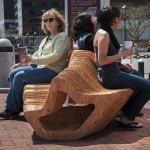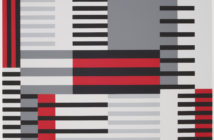Have you ever wondered how street furniture get selected, installed, and maintained? Things like benches, bus shelters, trash receptacles, plant containers, and bicycle racks are constantly present in our daily lives but rarely make a strong impression. Street furniture is usually commissioned by the city and implemented without fanfare or even announcement. What is often missing is an open, accessible process allowing the community to be well informed on public planning developments and to also contribute to these decisions.
The Design Museum Boston’s current exhibition Street Seats: Reimagining the Public Bench succeeds in providing public access and accountability in the decision-making for this project. In September 2012, designers from all over the world were invited by the Design Museum to create artistic, innovative, and sustainable public benches for Boston’s Fort Point Channel. Out of 178 proposals, 17 Semi-Finalists are on display along the channel until October. Instead of simply gathering a panel of judges and quickly installing a winning design, the Design Museum has allowed the commission process itself to become the focus, giving the public an inside look at the selection process while providing wonderfully diverse seating for the community.
As a popup organization, the Design Museum moves around the city. For the opening of "Street Seats" on Saturday, April 27 they set up shop in the parking lot directly next to the exhibit. From 1-3 PM, the channel was packed with people visiting the benches, taking tours with museum volunteers, and buying lunch from the many food trucks gathered for this celebration. Visitors enjoyed evaluating the benches and voting for the People’s Choice Award, which had a $2,000 cash prize. This prize gave people a sense of inclusion and made them feel that their personal opinions were heard. On a tour I attended, the innovative designs were appreciated by all, but more commonly heard was a practical exclamation of "not comfortable!"
At each bench, there is an illuminated Beacon — signage with information regarding the design, team, and process — providing viewers with the background to evaluate works independently and also creating a more formal museum exhibition feel for this outdoor venue. QR Codes link viewers to a mobile app with videos and additional images, allowing attendees to stay involved in the exhibition even after they have left the site. These features allow the unknowing passerby to engage with this exhibition fully and encourage interaction.
The most successful benches in this exhibit strongly reference the Fort Point area. The two winning designs, as decided by the Design Museum’s panel of judges, recognize the dynamism and evolution of the community. Runner-up luminUS, designed by local Dyer Brown Architects & Chapman Construction, seeks to represent Fort Point’s dual identities as both a traditionally artistic center and an up-and-coming Innovation District. The designers use polished glass and sculptural design to represent the artistic side, and a solar panel to represent commerce and technology. Bowsprit, the Grand Prize winning design by graduate students at the Georgia Institute of Technology, uses aluminum to signify the new technology-driven Fort Point and reclaimed wood to honor its past as a maritime economy.
Street Seats is organized by the Design Museum Boston in collaboration with the City of Boston and is on view through October 6, 2013 along Boston Harborwalk, Fort Point Channel — open 24/7. See each of the 17 unique, innovative public benches on display along with displays showing how each was designed.
- Photo courtesy of Diana Ye.
- Photo courtesy of Diana Ye.
- Photo courtesy of Diana Ye.
- Photo courtesy of Megan Klarenbach








